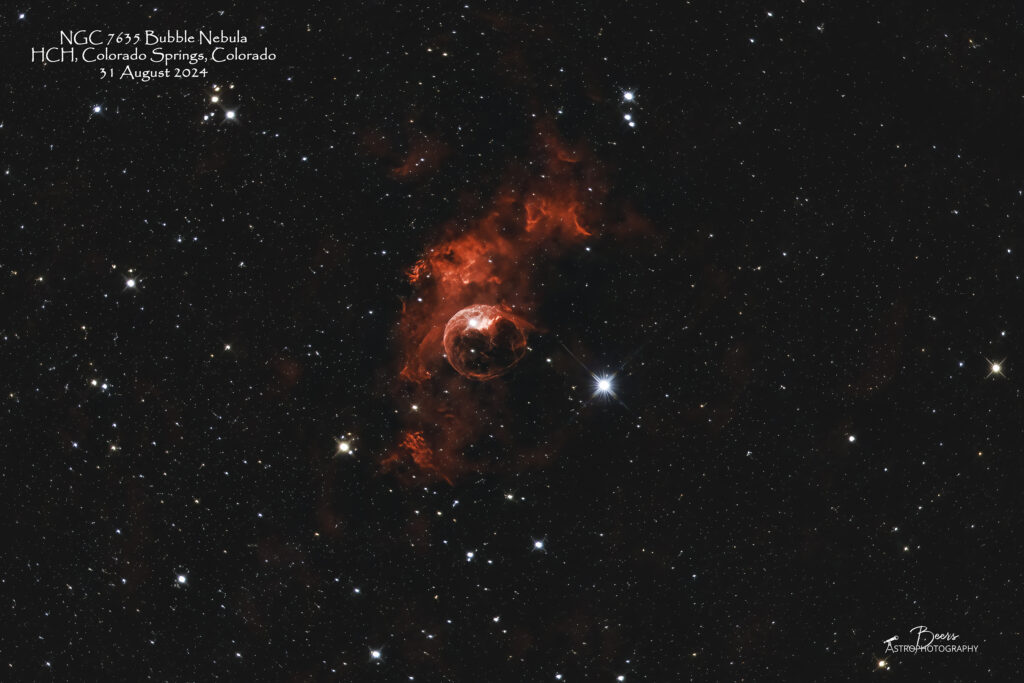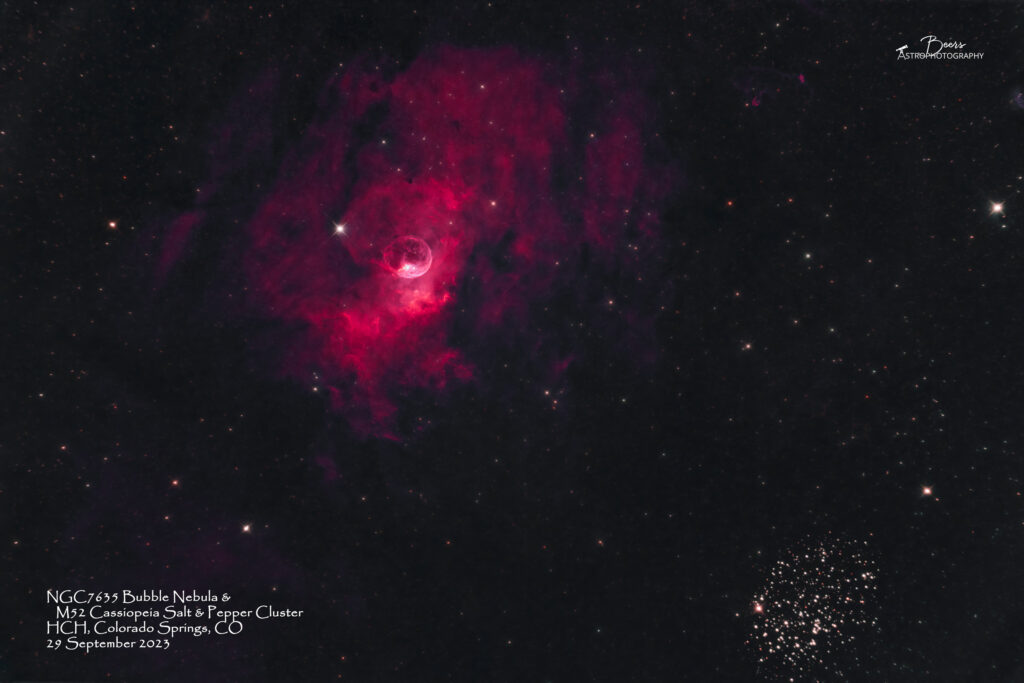
Fun facts
NGC 7635, also known as the Bubble Nebula, Sharpless 162, or Caldwell 11, is an H II region emission nebula in the constellation Cassiopeia. It lies close to the open cluster Messier 52. The “bubble” is created by the stellar wind from a massive hot, 8.7 magnitude young central star, SAO 20575 (BD+60°2522). The nebula is near a giant molecular cloud which contains the expansion of the bubble nebula while itself being excited by the hot central star, causing it to glow. It was discovered in November 1787 by William Herschel. The star BD+60°2522 is thought to have a mass of about 44 M☉.
Other Catalog Designations: Bubble Nebula, Sharpless 162 (Sh2-162), Caldwell 11|
Subtype: HII region emission nebula
Distance from Earth: 7,100 – 11,000 light years
Radius: 3-5 light years (radius)
Apparent Size: 15′ × 8′
Magnitude: ~10
Constellation: Cassiopeia
{Target information derived from: https://en.wikipedia.org/wiki/Bubble_Nebula }
Capture & Processing Notes:
This was “first light” with Big Zeus on the Rainbow Astro RST-300 and with the ZWO EAF auto focuser. I haven’t used Big Zeus since I purchased the RST-300 mount (or EAF). Although Thingiverse’s MikeinWI (whose design I used to create Big Bertha’s EAF bracket design) designed and made a 10″ RC bracket for Big Zeus in late 2023, I’ve never used it. So…I finally took Big Bertha off the RST-300 and replaced her with Big Zeus, attaching the EAF with bracket; then ensuring I had updated profiles in SGP for the RST-300 and Big Zeus, I built the plan to image the Bubble Nebula.
Started the evening with the SGP autofocus step size test. This is where I learned that the autofocus step-size is a function of the filter, not the telescope – after running the step-size exercise with Big Zeus (focal length = 1600mm) and the LPro filter, I came up with same step size (175) as I did with the Southern Cross (focal length = 600mm) and the LPro filter.
Then I attempted to start the sequence and realized that while I had updated and confirmed the SGP profile with the Big Zeus information, I had not updated the PHD2 equipment profile. My first clue, which I failed to pick up on, was that when I started up the sequence and connected all equipment, something was opening up the ASCOM driver for the EQ-6R (the old mount, replaced by the RST-300 controlled by the iHubo ASCOM driver). When I watched the PHD2 calibration routine not move the mount – it finally dawned on me. So, I updated the PHD2 equipment profile, shut down everything and powered it all back up and restarted the sequence – amazing how things work when you have all the control software pointing to the correct equipment.
Sequence Plan (31Aug2024): Gain: 158, Temp: -0°C, offset=30. 80x5min. Captured 31Aug2024, 22:08MDT – 1Sep2024, 0534MDT. Total exposure time: 400min, 6:40hrs (ASI2400-BZ-LPro)
Processing: Captured in SGP, stacked in APP (HaOIII Color), star removal with Starnet++, processing with LR/PS
Equipment
All equipment controlled by HP Probook running Sequence Generator Pro v4.4.0.1339.
Autoguiding: Orion 60mm Multi-Use Guide Scope with Orion StarShoot AutoGuider Pro Mono Astrophotography Camera (controlled by PHD2)
Imaging (ASI2400-BZ-LPro): ZWO ASI2400MC imaging camera on (Big Zeus) Orion 10″ f/8 Ritchey-Chretien Astrograph Telescope, Teleskop Service Flattener 1.0x for RC Telescopes (TS-RCFLAT2), Optolong L-Pro LP filter (LPro)
Autofocuser: ZWO EAF Electronic Automatic Focuser – Standard (New 5V Version) (EAF-5V-STD)
Mount: Rainbow Astro RST-300 (controlled by iHubo ASCOM driver)
Polar alignment: QHYCCD camera (controlled by Polemaster for polar alignment)
Other images of NGC7635 Bubble Nebula

Capture Notes:
Clear night (albeit full supermoon) gave me the chance to test out the new extension tube I finally was successful in convincing Orion that I needed, they admitted they had it in stock, and “allowed” me to purchase it. Also, wanted to experiment with the Teleskop Field Flattener, that with the first try with the ASI2400MC had created more coma than it corrected. I had looked up the design distance between the sensor and the flattener, the manufacturer said it should be “a generous” 109mm. I measured from the glass plate (not sure how far back the sensor is from there) to the sensor side of the FF, it seemed in the range of 109mm, so I convinced myself that I must have used an extra sleeve of the connection tube in previous attempts. Turns out that I had the same (worse coma with the FF than without) even with that recommended separation, so I stopped the sequence after one image, took off the FF, refocused, and restarted the sequence without the use of the FF. There is still some coma (which is annoying because I had intentionally framed the image to include the M52 cluster in the SE corner and the stars in the cluster are pretty coma-affected). Other than that, the collection went remarkably well throughout the night. The sequence did abort somewhere after 2333MDT (transit was 2347MDT). I came out to do the meridian flip at about midnight, and was able to successfully restart the sequence (on the correct side of the meridian) without issue. So the mystery of meridian flip +/- 15minutes continues…
Equipment
Polar alignment: QHYCCD camera (controlled by Polemaster)
Imaging stream: (Big Bertha) Orion 8″ f/8 Ritchey-Chretien Astrograph Telescope, ZWO ASI2400MC#2 imaging camera, Optolong LeXtreme light pollution filter
Mount: SkyWatcher EQ6‑R PRO Synscan mount (controlled by ASCOM driver)
Autoguider: Orion 60mm Multi-Use Guide Scope, Orion StarShoot AutoGuider Pro Mono Astrophotography Camera (controlled by PHD2)
All equipment controlled by Windows 11 HP Probook (DSO-CTRL-2) running Sequence Generator Pro v4.2.0.16.
Capture & processing notes
Sequence plan: Gain: 158, Temp: -0°C, offset=30, Bin: 1×1, 100x5min. Total exposure time: 8:20hrs.
Captured: Captured 29Sep2023 2042MDT – 30Sep2023, 0547MDT.
Shooting location: HCH, Colorado Springs, Colorado
Processing: Captured with SGP. Stacked in APP (HaOIII Color, HaOIII extract Ha, HaOIII extract OIII). Star removal with Starnet++. Processed in LR/PS.
I performed the Ha and OIII extract algorithms and brought the results into LR and PS to use Nico Carver’s dual narrowband colorizing technique (3 Ways to edit Dual Narrowband Astrophotography! at https://www.youtube.com/watch?v=hLGjXJ3FxO0&t=2181s) a try with this image. I ended up starting with my “standard” process (in quotes because I really have no standard – as each image is processed with a slightly different workflow) that includes using the Alyn Wallace presets (https://alynwallacephotography.com/astro-workflow-lightroom-presets). That turned out with a satisfactory result (at least for now until I catch up on processing and planning). So, again, I’m calling this a “front patio placeholder” and adding to my “reshoot in dark skies” list…
